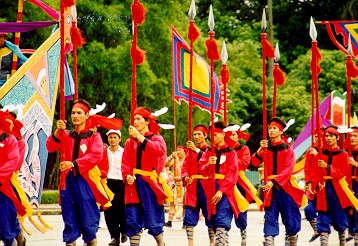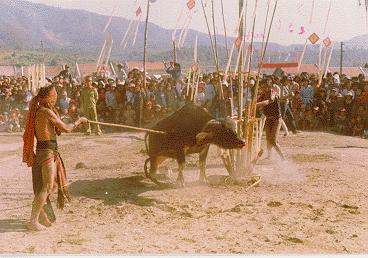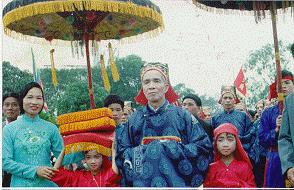Culture
Vietnam boasts an age-long and special culture that is closely attached to the history of the formation and development of the nation.
Historians have shared a common view that Vietnam has got a fairly large cultural community that was formed around the first half of the first millennium before Christ and flourished in the middle of this millennium. That was Dong Son cultural community. This culture attained a degree of development higher than that of others at that time in the region and had its own characteristics but still bore the features of Southeast Asian culture because of the common South Asian racial root (Southern Mongoloid) and the water rice culture. Different development routes of local cultures in various areas (in the deltas of Hong (Red) river, Ma (Horse) river, Ca river and so on...) joined together to form Dong Son culture. This was also the period of the very "embryonic" state of Vietnam in the form of inter- and super-village community, which come into being and existed in order to resist invaders and to build and maintain dykes for rice cultivation. From this pattern of "embryo" state, primitive tribes grew into nations.
|
|
|
Dragon dance |
The period of Van Lang-Au Lac culture (lasting for nearly 3,000 years up to the end of the first millennium before Christ) in the early Bronze Age with 18 Hung kings was regarded as the first apogee in the history of the Vietnamese culture, which was typified by the Dong Son bronze drum and stable technique of cultivating water rice.
The post-Chinese domination period was characterized by the two parallel trends of Han assimilation and anti-Han assimilation. The Dai Viet (Great Vietnam) period was the second apogee of the Vietnamese culture. Throughout the time of independent feudal states, milestoned by the Ly-Tran and Le dynasties, the Vietnamese culture underwent comprehensive restoration and quick boom, under the tremendous influence of Buddhism and Taoism.
After the chaotic Le-Mac and Trinh-Nguyen period, when the country was separated, and since the Tay Son dynasty reunited the country and territory, the Nguyen dynasty tried to restore Confucian culture. They, however, failed because Confucianism had already been fading and the Western culture started to penetrate into the country. The period up to the end of French domination was marked by a cultural mix brought about by two opposite trends - i.e. of Europeanization and anti-Europeanization; that presents, the fight between patriotic culture and colonialist culture.
The period of modern Vietnamese culture has gradually taken shape since the 30’s and 40’s of this century under the banner of patriotism and Marxism-Leninism. Vietnamese culture, with the increasingly intensive integration into the world modern civilization and the preservation and enhancement of the national identity, promises to reach a new historical peak.
It can be said that there were three layers of culture overlapping each other during the history of Vietnam: local culture, the culture that mixed with those of China and other countries in the region, and the culture that interacted with Western culture. The most prominent feature of the Vietnamese culture is that it was not assimilated by foreign cultures thanks to the strong local cultural foundations. On the contrary, it was able to utilize and localize those from abroad to enrich the national culture.
The Vietnamese national culture emerged from a concrete living environment: a tropical country with many rivers and the confluence of great cultures. The natural conditions (temperature, humidity, monsoon, water-flows, water-rice agriculture ...) exert a remarkable impact on the material and spiritual life of the nation, the characteristics and psychology of the Vietnamese. However, social and historical conditions exert an extremely great influence on culture and national psychology. Thus, there are still cultural differences between Vietnam and other water-rice cultures like Thailand, Laos, Indonesia, India and so on. Though sharing the same Southeast Asian cultural origin, the Vietnamese culture was transformed and bore East Asian cultural characteristics because of the long domination of the Chinese Han dynasty and the imposition of its culture on Vietnam.
The Vietnamese nation was formed early in the history and often had to carry out wars of resistance against foreign invaders, which created a prominent cultural feature: a patriotism that infiltrated and encompassed every aspect of life. Community factors with primitive origin were amalgamated early in the history and became the foundations for the development of patriotism and national consciousness. Continual wars were the major cause of the vicissitudes of the Vietnamese social development history. All the social and economic structures were often dismantled by wars, so the social development could hardly reach its peak. Also because of the destruction of wars, Vietnam has virtually no gigantic cultural and artistic construction, or if any, they could not have been preserved intact.
Vietnam boasts 54 ethnicities living across the country. Each ethnicity has its own cultural colour, thus, the Vietnamese culture is a diversified unification. Apart from the typical Viet-Muong culture, there are other cultural groups like Tay-Nung, Thai, Cham, Hao-Ngai, Mon-Khmer, H’Mong-Dao, and especially Tay Nguyen groups that still maintain fairly diverse and comprehensive traditions of a purely agricultural society that is closely attached to forests and mountains.
The followings are the overview of major cultural aspects:
1. Philosophy and ideologies
At the start, with primitive and rudimentary cognition of materialism and dialectics, Vietnamese thought was mixed with beliefs. However, originating from agricultural culture that differs from nomadic culture by the appreciation of stillness over movement and closely related to natural phenomena, the Vietnamese philosophy paid special attention to relations that was typified by doctrine of yin and yang and the five basic elements (not exactly the same as the Chinese doctrine) and manifested by the moderate lifestyle tending towards harmony.
Afterwards, the influence of Buddhism, Confucianism and Taoism, that were conciliated and Vietnamized, contributed to the development of the Vietnamese society and culture. Particularly, Zen-Buddhists in the Tran dynasty came up with the interpretation of most philosophical subjects that was set forth by Buddhism (Heart- Buddha, being or not being, life and death) in an original and distinguished way. Although Confucianism flourished afterward, many famous Vietnamese confucianists did not stick bindly to Confucianism and Mencianism, but rather adopted the spirit of Buddhism and Taoism to make their ideology more open, closer to the people and more harmonious with the nature.
|
|
|
Festival |
Under autocratic dynasties, deep feudal ideologies were imposed on farmers and bound women, however, village democracy and primitive community still existed on the basis of self-supplied agriculture. Farmers’ thoughts that penetrated deeply into the Vietnamese agricultural society had many positive and typical features of the traditional Vietnamese. Farmers were the core of wars of resistance and uprisings against foreign invaders. Many talented generals, topped by Quang Trung Nguyen Hue - the hero of the common people in the 18th century, came from farmers.
The policy that facilitated agriculture and restrained trade, prevailing in the Nguyen dynasty, blocked the development of city-dweller's consciousness. In the past time, the Vietnamese ranked agriculture and education as their first and second priorities of occupations, while having a low opinion of business people. Other trades were regarded as minor ones, including cultural activities.
In the 19th century when Vietnamese feudalism faded and Chinese civilization declined, Western culture started to penetrate our countries, following the colonialists’ guns. The working class formed at the start of the 20th century as a result of the colonial exploitation programs. Marxism-Leninism was introduces in Vietnam in the '20s and '30s, combining with patriotism to become a momentum of historical changes, which led the country up to independence, democracy and socialism. The person representing this era was Ho Chi Minh, who was recognized by the international community and UNESCO as Vietnamese hero of national liberation and great man of culture. The ailing national bourgeoisie could only implement a number of partial reforms in the first half of the 20th century.
That Vietnam did not have its own philosophical and ideological theoretical system and lacked world-class philosophers does not mean that it does not have ways of living and ideologies suitable to its nation.
The agricultural society is characterized by the village community with many prolonged primitive vestiges that have formed the specific characteristics of the Vietnamese. Those were the thoughts of dualism, a concrete way of thinking that was tilted to emotional experiences rather than rationalism and preferred images to concepts. However, it was also a flexible, adaptable, and conciliatory way of thinking. This was a way of living that highly valued emotional ties and attachment to relatives and the community (because "there would be no home in a lost country" and "the whole village rather than a sole roof would be engulfed by flood"). This was a way of behaving toward conciliatory, equilibrium and relations-based settlement of conflicts and disputes. This way of living could cope accordingly with the situation, which many times in the history was successful in using suppleness to prevail over firmness and weakness to resist strength.
|
|
|
Buffalo offreing ritual |
On the scale of spiritual values, the Vietnamese highly appreciate "Benevolence" and closely combined it with "Righteousness" and "Virtues"; no benevolence and righteousness are tantamount to no virtues. Nguyen Trai once described the Vietnamese concept of Benevolence and Righteousness as the opposition to fierce violence, which was enhanced to the foundation for the policy of ruling as well as saving the country. The Vietnamese understood that Loyalty meant being loyal to the nation, which was higher than the loyalty to the ruler, and respected Piety without being so bound with the framework of family. Happiness was also among the top social values; people often make compliments on the happiness of a family rather than wealth and social position.
On the road of industrialization, modernization and integration into the international community, Vietnam will have to overcome some shortcomings in its traditional culture like conservatism, and parochialism, egalitarism, and the weakness in practical organization ...
2. Customs and Practices
The Vietnamese people are realistic, prefering to "eat stodgy food and to wear hard-wearing clothes". Eating comes first. The Vietnamese eating habit tends towards vegetarianism ; rice and vegetables are the main course of the meal that may be diversified by aquatic products. Boiling is a special way of cooking of the Vietnamese people. Vietnamese people like a synthetic food processing style that involves many materials and ingredients. Today, although meat and fish are the main dishes of the meal, the Vietnamese do not forget pickled egg-plant.
The Vietnamese preferred to wear light, thin, well-ventilated kind of clothing that originated from plants and was suitable for such a tropical country as Vietnam, with grey, indigo and black colours. Men’s clothing changed from loin-cloth with bare upper half of the body to short jackets and Vietnamese traditional trousers (re-designed from Chinese trousers). In the past, women often wore brassieres, skirts and four-piece long dresses that were later modified to the modern ao dai. In general, Vietnamese women adorned themselves subtly and secretively in a society where "virtue is more important than appearance". Old/time clothing also paid attention to kerchiefs, hats and belts.
The old-style Vietnamese house was related to the watery environment (stilted house with curved roof). Then came thatch-roofed house with clay walls, which were built mostly from wood and bamboo. This kind of house did not stand too high to avoid high winds and storms, and more importantly, the house should face to the South direction to be free from hot and cold weathers. The interior of the house was also not so spacious to leave room for the courtyard, pond, and garden. Also, the Vietnamese thought that "spacious home was no better than sufficient food". Sizeable ancient architectures were often built shrouded and in harmony with natural environment.
The traditional means of transport is waterways. Ship of all types together with the river and the wharf, are familiar in the Vietnamese geological and humanitarian images.
Vietnamese customs of weddings, funerals, holidays and rituals all are attached to village community. Marriages not only reflecte the lovers’ desire but also had to meet the interests of the family lines, the village; thus, the choice for future bride or bridegroom was done very carefully, which had to go through many formalities from the plighting ceremony, the official proposal to the bride’s family, the wedding to the marriage tie, the ritual of sharing bridal cup of wine, the newly-weds’ first visit to the bride’s family. Besides, the bride had to pay a fine in order for her to be accepted as a new member of the village. Funeral service is also proceeded very thoroughly to express the grief and see off the relative into the other world. The family of the deceased does not have to take care of the service by themselves, they are also given a helping hand by the neighbors.
Vietnam is the country of festivities which take place all year round, especially in spring when there is little farming work. The major festivities are Nguyen Dan (Lunar New Year ), Mid-First month , Han thuc (cold food) , Doan Ngo (double five) , Mid-Seventh month , Mid-Autumn Festival, Ong tao (the god of the kitchen) etc... Each region has its own ritual holidays, the most important of which are agricultural rituals (such as the rituals of praying for rain, getting down to the rice field, and new rice...) and trades’s rituals (like the rituals of copper casting, forging, making fire crackers, and boat racing...). Besides, there are also rituals dedicating to national heroes and religious and cultural services (e.g, Buddhist rituals). Ritual holidays are usually divided into two parts: the service is carried out for blesses and thanksgivings, the holiday is the cultural activities of the community consisting of many folk games and contests.
3. Beliefs and Religions
The Vietnamese folk beliefs since the ancient time consist of belief in fecundity, worship of nature and worship of man. Human beings need to be reproduced, crops need to be lushly green for the nourishment and development of life, so belief in fecundity came into existence. In Vietnamese, this belief lasted for long in two forms: worshiping male and female genitals (different from India where only male genital was worshipped) and worshiping sexual intercourse (of both human beings and animals; right in Southeast Asia, there are few nations worshiping this act. The vestiges of this belief are found in relics carved on sculptures and stone poles, in decorative patterns in Tay Nguyen sepulchres, in some customs and kinds of dance, particularly in figures and patterns engraved on ancient bronze drums.
|
|
|
Festival ritual at Do Temple |
Water-rice agriculture that depended much on natural factors ignited the belief of worshiping nature. In Vietnam, this belief was polytheism and respect for goddess, and worshipp of animals and plants as well. A research book published in 1984 listed 75 goddesses, mostly matriarchal goddesses, also called Mau (ancient people not only worshipped the Creator but also Mau Cuu Trung which was a female Creator, as well as Mau Thuong Ngan, River Goddess and so on). Regarding botany-worshiping beliefs, the rice plant was most venerated, the next were the banyan-tree, the areca-tree, the mulberry tree and the gourd. In respect of animal-worshiping beliefs, unlike nomadic culture that worships fierce wild animals, Vietnamese tend to worship gentle species of animals like stag, deer, frog, especially those which are easy to come by in the riverside regions like water-birds, snakes, and crocodiles. The Vietnamese proclaimed themselves as belonging to the Hong Bang family line and the Tien Rong breed (Hong Bang was the name of a huge species of water-bird, Tien, or Fairy, was deification of an egg-laying species of bird, Rong, or Dragon, was an abstract image of snake and crocodile). The ascending dragon that was born in the water is meaningful and special symbol of the Vietnamese nation.
Among the human-revering beliefs, the custom of worshiping ancestors is the most popular, which nearly become one belief of the Vietnamese (also called Dao Ong Ba in the Cochinchina). The Vietnamese choose the death-day rather than the birthday to hold a commemorative anniversary for the deceased. Every family worships Tho cong, or the God of Home, who takes care of the home and blesses the family. Every village worships its Thanh hoang, the God of the village, who protects and guides the whole village (the Vietnamese always honour the people who rendered distinguished services for villagers or national heroes who were born or died in the village to be their Thanh hoang). The whole nation worships the very first kings, sharing the common ancestors’ death anniversary (the Ritual of Hung Temple). Particularly, the worship of Tu Bat Tu, or the Four Immortal Gods, namely, God Tan Vien (preventing flooding), God Giong (resisting and defeating foreign invaders), God Chu Dong Tu (together with his wife growing out of poverty to consistently build his fortune) and Goddess Lieu Hanh (heavenly princess who left Heaven for the earth in the yearning for happiness) has been regarded as extremely beautiful national values.
Although turning into superstition in some specific cases, folk beliefs have lasted consistently and mixed with orthodox religions.
Therevada Buddhism might have been imported directly into Vietnam from India through sea routes since the 2nd century A.D. Vietnamese Buddhism stays on earth rather than ascends up to heaven, attaches to exorcism and prayers for wealth, happiness and longevity rather than heads toward nirvana.
More information can be found from:
Click here




